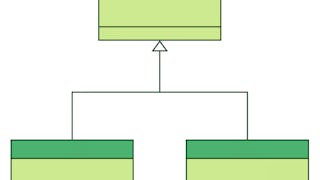An applied analysis and design class that addresses the use of object-oriented techniques. Topics include domain modeling, use cases, architectural design and modeling notations. Students apply techniques in analysis and design projects. Focus is on key object-oriented elements and concepts.



Object-Oriented Analysis and Design: Foundations & Concepts
Ce cours fait partie de Spécialisation Object-Oriented Analysis & Design

Instructeur : Bruce Montgomery, PhD, PMP
Inclus avec 
Expérience recommandée
Ce que vous apprendrez
Apply industry-standard languages such as Java to object-oriented software designs.
Design object-oriented solutions with structural, behavioral, and composite graphical UML diagrams
Design test cases appropriate to object-oriented applications using JUnit.
Compétences que vous acquerrez
- Catégorie : Object Oriented Programming (OOP)
- Catégorie : System Design and Implementation
- Catégorie : Object Oriented Design
- Catégorie : Unit Testing
- Catégorie : Software Testing
- Catégorie : Test Driven Development (TDD)
- Catégorie : Software Design Patterns
- Catégorie : Java
- Catégorie : Software Design
- Catégorie : JUnit
- Catégorie : Unified Modeling Language
- Catégorie : Software Engineering
- Catégorie : Java Programming
Détails à connaître

Ajouter à votre profil LinkedIn
4 devoirs
Découvrez comment les employés des entreprises prestigieuses maîtrisent des compétences recherchées

Élaborez votre expertise du sujet
- Apprenez de nouveaux concepts auprès d'experts du secteur
- Acquérez une compréhension de base d'un sujet ou d'un outil
- Développez des compétences professionnelles avec des projets pratiques
- Obtenez un certificat professionnel partageable

Il y a 5 modules dans ce cours
An introduction to the benefits and challenges in applying Object-Oriented Analysis and Design (OOAD). The overall specialization and the instructor are introduced here. Then the challenges of developing software to support changing requirements are reviewed, and the Object-Oriented (OO) paradigm is presented as a possible approach to better analysis and design. Lectures examine how the OO approach differs from other programming paradigms and how it can provide helpful perspectives in conceptual, specification, and implementation design stages. Students should consider their background in Java and begin appropriate tutorial study at a level needed to allow use of the language in course projects (suggested resources are provided).
Inclus
8 vidéos3 lectures1 devoir2 sujets de discussion
The module provides a review of core OO foundational concepts, including abstraction, encapsulation, modularity, polymorphism, delegation, inheritance, identity, and more. Key OO terminology for discussing aspects of class and object design are also presented. Finally, Java – our course programming language - is reviewed, not in a full development tutorial, but rather in examining the languages elements that support effective OO design and development. Resources are provided for supporting Java tutorial needs, and an example of Java development is provided as a first foray into OOAD development projects.
Inclus
5 vidéos2 lectures1 devoir1 évaluation par les pairs2 laboratoires non notés
The Unified Modeling Language is a method for performing OOAD using graphical diagramming. The module focuses on UML as an effective tool for our design efforts – class diagrams can easily show major relationships and responsibilities of collaborating class networks; use case diagrams can help with analysis of critical user tasks needed for a successful system analysis; and the behavioral diagrams (sequence, state, and activity) can show details of messaging and command flow through applications. UML is regularly used in both academic and industry settings for designing and describing complex OO systems, and it will also be part of many OOAD course development projects.
Inclus
5 vidéos1 lecture1 devoir1 évaluation par les pairs
Testing in any software system is a recognized challenge; in an object-based system where communicating elements hold their own state, data, and functionality it can be even more difficult to find effective test suites. The module looks at the core issues with software test, and at what approaches are typically used in industry for test at each stage and level of a software project. There is a special focus on messaging and serialization, two key elements of connectivity in OO systems that have their own challenges and approaches for thorough test and development. Finally, the module looks at a first-level view of JUnit, a unit testing framework used in industry with Java that will also be used (in a simple fashion) as a tool for grading and verifying course programming work.
Inclus
5 vidéos1 lecture1 devoir1 devoir de programmation1 évaluation par les pairs
The capstone project presented here lets the student confirm their understanding of the three main tools employed in OOAD projects – Java, JUnit, and UML. While the capstone is not an extreme challenge, it does provide a common checkpoint to ensure skills are in place for more challenging OO design and development in the two follow-on courses – and provides the student with an opportunity to review their readiness to continue in the specialization.
Inclus
2 vidéos2 lectures1 devoir de programmation1 évaluation par les pairs
Obtenez un certificat professionnel
Ajoutez ce titre à votre profil LinkedIn, à votre curriculum vitae ou à votre CV. Partagez-le sur les médias sociaux et dans votre évaluation des performances.
Préparer un diplôme
Ce site cours fait partie du (des) programme(s) diplômant(s) suivant(s) proposé(s) par University of Colorado Boulder. Si vous êtes admis et que vous vous inscrivez, les cours que vous avez suivis peuvent compter pour l'apprentissage de votre diplôme et vos progrès peuvent être transférés avec vous.¹
Instructeur

Offert par
En savoir plus sur Software Development
 Statut : Essai gratuit
Statut : Essai gratuit
University of Colorado Boulder
 Statut : Essai gratuit
Statut : Essai gratuit
University of Colorado Boulder
 Statut : Essai gratuit
Statut : Essai gratuit
University of Alberta
 Statut : Essai gratuit
Statut : Essai gratuit
LearnQuest
Pour quelles raisons les étudiants sur Coursera nous choisissent-ils pour leur carrière ?





Ouvrez de nouvelles portes avec Coursera Plus
Accès illimité à 10,000+ cours de niveau international, projets pratiques et programmes de certification prêts à l'emploi - tous inclus dans votre abonnement.
Faites progresser votre carrière avec un diplôme en ligne
Obtenez un diplôme auprès d’universités de renommée mondiale - 100 % en ligne
Rejoignez plus de 3 400 entreprises mondiales qui ont choisi Coursera pour les affaires
Améliorez les compétences de vos employés pour exceller dans l’économie numérique
Foire Aux Questions
Access to lectures and assignments depends on your type of enrollment. If you take a course in audit mode, you will be able to see most course materials for free. To access graded assignments and to earn a Certificate, you will need to purchase the Certificate experience, during or after your audit. If you don't see the audit option:
The course may not offer an audit option. You can try a Free Trial instead, or apply for Financial Aid.
The course may offer 'Full Course, No Certificate' instead. This option lets you see all course materials, submit required assessments, and get a final grade. This also means that you will not be able to purchase a Certificate experience.
When you enroll in the course, you get access to all of the courses in the Specialization, and you earn a certificate when you complete the work. Your electronic Certificate will be added to your Accomplishments page - from there, you can print your Certificate or add it to your LinkedIn profile. If you only want to read and view the course content, you can audit the course for free.
If you subscribed, you get a 7-day free trial during which you can cancel at no penalty. After that, we don’t give refunds, but you can cancel your subscription at any time. See our full refund policy.
Plus de questions
Aide financière disponible,


